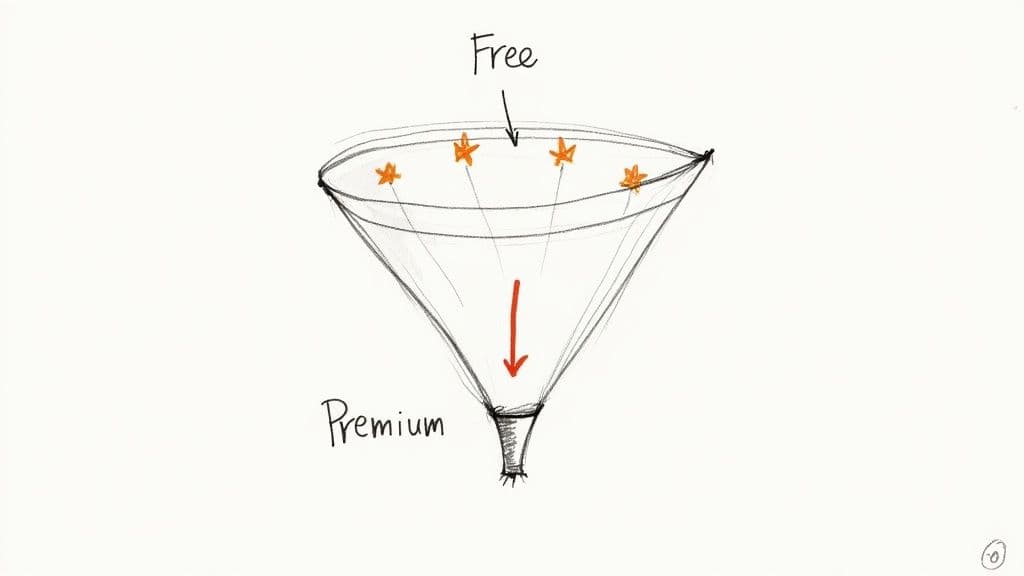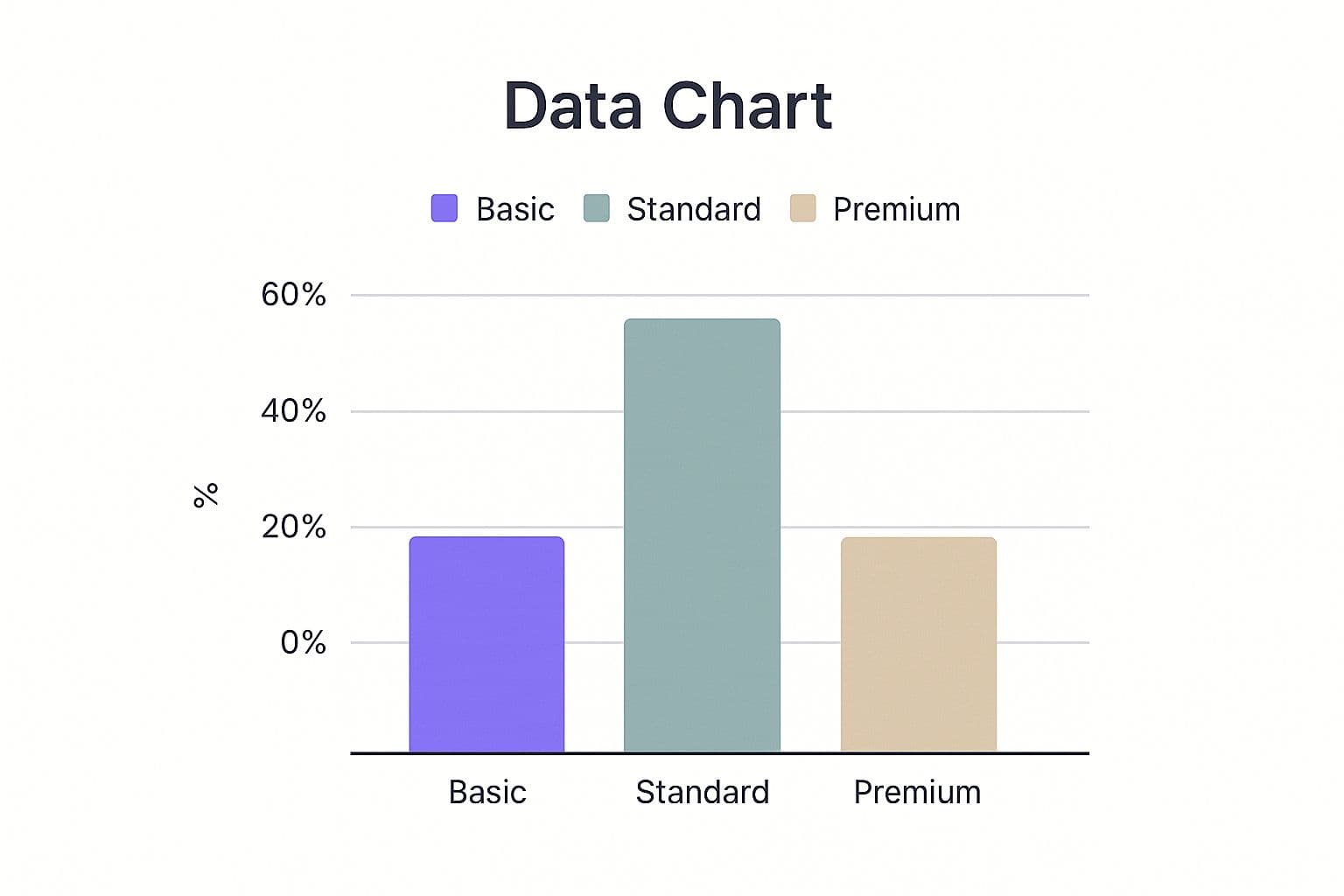Want to Turn Followers into Paying Subscribers?
Stop leaving money on the table. Most creators have an audience...but struggle to monetise. These eight proven subscription pricing examples are your secret weapon to unlock recurring revenue.
Why pricing matters: Your pricing model isn't just about how much you charge. It's a core part of your product strategy. It's how you position your value, attract the right customers, and scale sustainably. Get it wrong, and you'll leave money on the table - or worse, repel potential subscribers.
What you’ll learn: This listicle dives deep into eight powerful pricing structures:
- Freemium: The classic "free taste" strategy.
- Tiered Pricing: Good, Better, Best. Which one is right for you?
- Usage-Based Pricing (Pay-as-you-go): Charge for what they use.
- Per-User/Per-Seat Pricing: The enterprise staple, adapted for creators.
- Value-Based Pricing: Charge based on perceived value (not just cost).
- Flat-Rate Pricing: One price, all access. Simplicity at its finest.
- Hybrid/Blended Pricing: Combine the best of different models.
- Annual vs. Monthly Subscriptions: The psychology of commitment.
We'll dissect each model, revealing why it works (or doesn't). I'll share real-world subscription pricing examples and the tactics top creators use to nail their pricing. No corporate jargon, just actionable advice from one creator to another. Let's get into it.
1. Freemium Model
Want more members without bleeding your bank account on ads? Give them a taste. Freemium isn't a gimmick; it's a magnet. The freemium model lets prospects experience the core value of your offer before committing to a paid tier. This creates a natural conversion funnel, turning free users into paying subscribers.

70c03239-7c35-4261-aea8-606f2abec3e6.jpg
This model deserves its place in this listicle because it tackles one of the biggest hurdles creators face: building trust. It's a powerful subscription pricing example because it allows potential subscribers to "try before they buy", fostering confidence in your offering.
Examples and Why They Work
Think Spotify. Free users get music with ads. Premium users get ad-free listening, offline playback, and higher quality audio. The free tier showcases core value (music streaming) while the premium tier offers enhancements that justify the cost. The same principle fuels success for the likes of Canva, Dropbox, and Zoom, offering basic functionality for free and reserving premium features for paying users.
But don't limit your thinking to software. Freemium models thrive in other niches too. Imagine a fitness trainer giving away a weekly workout routine on their Telegram channel, then offering personalised plans and nutrition guides through a paid subscription. Or a digital coach offering free introductory group sessions, followed by one-on-one coaching for paying members. The possibilities are vast.
Tactical Tricks for Freemium Success
- Strategic Friction: Design your free tier with clever nudges towards premium. Think limited message history on Slack, or Canva’s watermark on free designs.
- Usage-Based Limits: These are more effective than time-based trials. Let users experience the full power of your product but limit how much they can use it. Dropbox’s free 2GB storage limit is a classic example.
- Highlight the Upgrade: Don't bury your upgrade prompts. Make them clear, concise, and compelling, emphasising the benefits of going premium.
Making Freemium Work for You
The key is to provide real value in your free tier while creating clear incentives to upgrade. Don’t make your free tier a crippled version of your paid product. Instead, offer a compelling taste of what’s possible. Showcase the core value, build trust, then let the upsells do the talking. Track your conversion metrics religiously. What's enticing users to upgrade? What's holding them back? Constantly optimise your freemium model to maximise your ROI.
2. Tiered Pricing Model
Want to maximise revenue without leaving money on the table? Tiered pricing is your answer. This model isn’t just about offering different price points; it’s about strategically segmenting your audience and giving them exactly what they’re willing to pay for. It's a core subscription pricing example because it allows you to cater to diverse needs and budgets, unlocking higher overall revenue potential.

infographic-89d7768c-b23f-4b3e-a587-fabe82b0030a.jpg
This bar chart visualises the distribution of subscribers across three tiers: Basic (20%), Standard (60%), and Premium (20%). As the chart clearly shows, the Standard tier captures the majority of subscribers, highlighting the importance of a compelling mid-tier offering.
Examples and Why They Work
Think Netflix. Basic gets you the essentials. Standard adds HD and more screens. Premium unlocks Ultra HD and even more simultaneous streams. Each tier caters to a different viewing habit and budget, maximising Netflix’s revenue potential. This strategy is replicated across industries, from Adobe Creative Cloud to HubSpot’s marketing suite.
But don’t just copy the big players. Think outside the software box. A fitness coach could offer tiered workout plans: beginner bodyweight routines, intermediate gym programmes, and advanced personalised coaching. Or a Telegram channel owner could offer tiered access: free public channel, paid member-only content, and premium VIP access with direct interaction. The options are vast.
Tactical Tricks for Tiered Pricing Success
- The Goldilocks Tier: Design your middle tier to be the most appealing. This is where the majority of your subscribers will land.
- Anchoring: Your highest tier, even if few subscribe, sets a benchmark that makes the other tiers look more affordable.
- Clear Value Differentiation: Don’t just add minor tweaks between tiers. Make the differences in features and benefits significant and obvious.
Making Tiered Pricing Work for You
Start by understanding your audience segments. What are their different needs and budgets? Then, craft tiers that directly address those needs. Regularly test your pricing. Are people gravitating towards a particular tier? Are there gaps in your offering? A/B test different price points and features to optimise your revenue. Track your conversion rates and churn for each tier. This data will tell you what's working and what needs adjusting. Don’t be afraid to experiment and iterate your way to the perfect tiered pricing strategy.
3. Usage-Based Pricing (Pay-as-you-go)
Want to charge people for exactly what they use? This isn't just for cloud servers anymore. Usage-based pricing lets you scale your income with your members' activity - perfect for unpredictable usage patterns. It's all about aligning value with cost.

351ec81b-cf2d-4984-8ab2-3321e30edd07.jpg
This model earns its place in this listicle because it offers ultimate flexibility, both for you and your subscribers. It's a powerful subscription pricing example because it directly connects value received with price paid, promoting transparency and fairness. No more feeling like you're overpaying for unused features.
Examples and Why They Work
Think cloud giants like AWS, Twilio, and Google Cloud. They charge based on computing resources used, API calls made, or emails sent. This makes perfect sense for businesses with fluctuating needs. But the principle applies elsewhere too. Imagine a language learning platform charging per lesson completed, or a fitness app charging per workout session accessed.
Tactical Tricks for Usage-Based Success
- Predictability Tools: Give users ways to estimate their usage. A usage calculator builds trust and prevents bill shock.
- Spending Caps: Let members set limits on their monthly spend. This offers control and encourages experimentation.
- Base Tier Options: Consider a small base tier with limited usage included. This gives a taste and onboards users gently.
Making Usage-Based Pricing Work for You
Usage-based pricing isn't about nickel-and-diming. It's about aligning value with usage. Clear, transparent pricing builds trust and attracts the right customers. Track your usage patterns closely. What are people using most? Where are they dropping off? Use this data to optimise your pricing tiers and maximise your revenue.
Out-of-the-Box Examples
- Co-working Spaces: Charge per hour or per day of office use, rather than a flat monthly fee. This caters to freelancers and remote workers with varying schedules.
- Educational Platforms: Charge per course module completed, rather than a single subscription for the entire library. This allows students to pick and choose based on their learning goals.
- Virtual Event Platforms: Charge per attendee or per minute of streaming time used, instead of a flat fee for access. This aligns costs with event size and duration.
4. Per-User/Per-Seat Pricing
Want predictable revenue? Per-user pricing is your engine. This model is straightforward: each user accessing your service pays a fixed fee. It's the go-to for B2B software and scales neatly with team size.
This model deserves a spot on this list because it offers transparent, predictable pricing for both you and your subscribers. No surprises, no hidden fees just clear value tied directly to usage.
Examples and Why They Work
Think Slack, Microsoft 365, or Zoom. Each charges per user, making it easy for businesses to budget and scale. This clarity is a key selling point, especially for larger organisations. Smaller teams benefit too, knowing exactly what they’ll pay as they grow.
But per-user pricing isn't limited to software giants. Imagine a coaching programme where each participant pays a monthly fee. Or an online course platform charging per student enrolled. This model brings predictable income and simplifies accounting.
Tactical Tricks for Per-User Success
- Volume Discounts: Reward larger teams with lower per-user fees. This encourages expansion and builds loyalty.
- Guest Access: Offer limited free guest accounts to showcase value and entice upgrades to full memberships.
- Flexible User Management: Make it easy for admins to add, remove, and manage users. Frictionless administration is key for larger clients.
Making Per-User Pricing Work for You
Don't just slap a price per user and call it a day. Consider different user roles. Perhaps offer tiered access with varying features and pricing. A "basic" user might have limited permissions compared to a "premium" user. This allows you to cater to different budgets and needs within the same organisation. Keep your pricing clear, offer volume discounts, and make user management a breeze. This builds trust and encourages growth within your existing client base. And don't forget those guest accounts * a powerful tactic to convert free users into paying customers.
5. Value-Based Pricing
Want to charge premium prices? Then deliver premium value. Value-based pricing isn't about adding up your costs and slapping on a margin. It's about understanding the transformation you deliver and pricing accordingly. This is how you command higher fees and build a sustainable, high-profit subscription business.
This model belongs in this listicle because it flips the script on traditional pricing. It forces you to think about the impact you have, not just the features you offer. This is a powerful subscription pricing example, especially for B2B or high-ticket offers.
Examples and Why They Work
Think Salesforce closing enterprise deals based on projected ROI. Or McKinsey Digital charging eye-watering fees for strategic consulting that reshapes entire businesses. These aren’t selling features; they’re selling transformation. Learn more about value-based pricing strategies for your own subscription model.
But it’s not just for enterprise giants. Imagine a fitness coach guaranteeing a specific weight loss target within a set timeframe. Or a business coach promising a quantifiable revenue increase for their clients. Suddenly, the price becomes a small investment compared to the potential return. This also works for digital products.
Tactical Tricks for Value-Based Success
- Quantify the Impact: Don't just say "improve productivity". Say "save 10 hours per week". Use hard numbers and data to back up your claims.
- Showcase Success Stories: Case studies are your secret weapon. Show how your service has delivered tangible results for others. This builds trust and justifies the price.
- Pilot Programmes: Offer a smaller, value-focused engagement to demonstrate your impact before committing to a long-term subscription.
Making Value-Based Pricing Work for You
Value-based pricing demands a deep understanding of your customer’s needs and pain points. What are their biggest challenges? How can you help them overcome those challenges and achieve their desired outcomes? Once you know that, you can position your pricing around the value you deliver. Think outcomes, not outputs. Track your value metrics. What results are your subscribers achieving? How can you amplify those results and, in turn, justify even higher prices?
6. Flat-Rate Pricing
Want predictable revenue? Give your members predictable pricing. Flat-rate pricing isn't flashy, but it's powerful. One price, everything unlocked. No tiers, no confusion, just pure, unadulterated access. This model deserves its place in this listicle because it screams simplicity and value, which resonates powerfully with today's subscription-fatigued consumer.
(Optional image not included)
This subscription pricing example shines because it eliminates decision fatigue. It's a breath of fresh air in a world of confusing tiered pricing. Think Netflix: one monthly fee for all the binge-watching your heart desires.
Examples and Why They Work
Netflix's success with this model is a testament to its power. They offer a single monthly fee for access to their entire library. Basecamp charges a flat rate for unlimited users, making it a no-brainer for growing teams. Buffer offers unlimited social accounts for a fixed price. The beauty lies in the simplicity and predictability.
But it's not just for software. Imagine a yoga studio offering unlimited classes for a single monthly fee. Or a meal prep service offering a weekly subscription for a set number of meals, regardless of the menu choices. The possibilities are endless. Think outside the digital box! A pottery studio could offer unlimited classes and open studio time for a fixed monthly membership.
Tactical Tricks for Flat-Rate Success
- Price it Right: Analyse your average customer value and set your price accordingly.
- Monitor Usage: Keep an eye on power users to ensure profitability. Consider usage caps for extreme cases if necessary.
- Market the Simplicity: Your core message should be the ease and value of a single price.
- Focus on Value, Not Features: Position your offering based on the overall benefit, not a laundry list of features.
Making Flat-Rate Work for You
Flat-rate thrives on transparency and perceived value. Don't undervalue your offering. Highlight the all-inclusive nature of your subscription. Make sure the perceived value outweighs the price. Track churn and feedback religiously. What’s making members stay? What’s making them leave? Continuously optimise your pricing and offering based on real data. This model’s simplicity is its strength, but it requires careful planning and constant refinement to truly shine.
7. Hybrid/Blended Pricing
Want to capture every possible customer, from the freebie seeker to the enterprise giant? Hybrid pricing is your answer. It’s not about throwing pricing models at a wall and seeing what sticks. It's a strategic blend designed to maximise revenue by catering to different needs and budgets. This model deserves a spot on this list because it allows you to fine-tune your offerings and extract maximum value across your entire audience.

embed
Examples and Why They Work
Think Slack. They've nailed the hybrid model. A free tier pulls users in. Per-user pricing caters to growing teams. Custom enterprise plans reel in the big fish. This strategy works because it offers an entry point for everyone while providing premium features and dedicated support for those willing to pay. HubSpot follows a similar playbook with their freemium, tiered, and add-on module structure. Even Shopify blends tiered pricing with transaction fees and an app marketplace, creating multiple revenue streams. Learn more about Hybrid/Blended Pricing and membership growth strategies at this link.
Tactical Tricks for Hybrid Success
- Simplicity is Key: Even with multiple components, your core pricing should be easy to grasp. Confusing pricing kills conversions.
- Targeted Combinations: Don't randomly mix models. Match specific combinations to distinct customer segments.
- Pricing Calculators: Empower potential subscribers to see the cost based on their needs. This transparency builds trust.
Making Hybrid Pricing Work for You
Hybrid pricing isn't just for software giants. Imagine a fitness coach offering a free weekly workout, a tiered subscription for personalised plans, and add-on sessions for one-on-one coaching. Or an online course creator offering a free introductory module, a tiered subscription for the full course, and an add-on community forum for exclusive access and Q&A. Carefully consider your audience and tailor the components of your hybrid model to meet their diverse needs. Monitor which components drive the most revenue and optimize accordingly. Don't be afraid to experiment and tweak until you find the perfect blend that maximises your ROI. Don't be afraid to explore out-of-the-box ideas, such as combining a subscription for core content with a separate membership for access to a live community, or offering usage-based pricing for specific premium features within a tiered structure. The key is to strategically align your pricing with the value you deliver.
8. Annual vs Monthly Subscription Pricing
Want predictable revenue? Lock it in. Annual vs. monthly pricing isn't just about offering a discount; it's about building a stable, predictable income stream. This model lets subscribers choose their commitment level, balancing their flexibility with your need for consistent cash flow. This pricing strategy deserves its place in this listicle because it directly impacts your bottom line and empowers you to forecast with confidence. Plus, happy customers paying annually equals less churn to chase.
Examples and Why They Work
Think Adobe Creative Cloud. They've nailed this. They offer monthly access for flexibility, but dangle a juicy annual discount for commitment. Notion does the same, offering a 20% saving on annual plans. Grammarly, GitHub, and Asana all use this tiered approach, highlighting the total savings upfront. This works because it caters to different customer needs while incentivising the higher-value annual option.
But this isn’t just for software giants. Imagine a fitness coach offering monthly gym access alongside a discounted annual membership. Or an online course creator providing monthly module access versus a full-year programme at a reduced price. Learn more about... the strategic balance between monthly flexibility and annual commitment. The core principle is to offer choice while making the annual option the most compelling.
Tactical Tricks for Pricing Success
- Sweeten the Deal: Aim for a 15-25% discount on annual plans. Make the savings crystal clear. Don't bury the numbers.
- Trial Before You Commit: Let potential annual subscribers try a month before they leap. This builds trust and mitigates risk.
- The Middle Ground: Consider a quarterly option as a stepping stone between monthly and annual. It provides a good balance for some subscribers.
- Beyond Price: Offer additional perks for annual subscribers. Think exclusive content, priority support, or bonus features.
Making Temporal Pricing Work for You
Don’t just slap a discount on your annual plan and call it a day. Highlight the value. Emphasise the total savings. Make it a no-brainer. Think about adding those extra perks to truly differentiate your annual offering. Track which pricing tiers are most popular. What's converting monthly users to annual? What's holding them back? Optimise your pricing strategy based on real data and customer feedback. This isn't set-it-and-forget-it. This is dynamic pricing that adapts to your audience.
Subscription Pricing Models Comparison
| Pricing Model | Implementation Complexity 🔄 | Resource Requirements ⚡ | Expected Outcomes 📊 | Ideal Use Cases 💡 | Key Advantages ⭐ |
|---|---|---|---|---|---|
| Freemium Model | Moderate complexity managing free + paid tiers | High infrastructure cost for free users | Moderate conversion (2-5%), large user base | Software with network effects, viral potential | Low entry barrier, product trial, viral growth |
| Tiered Pricing Model | Moderate to high complexity designing tiers | Moderate - multiple plan maintenance | Revenue maximization across segments, clear upgrades | Businesses serving varied customer segments | Appeals to diverse users, clear upgrade path |
| Usage-Based Pricing | High complexity in metering and billing | High - real-time tracking and metering systems | Revenue scales with usage, unpredictable cash flow | Services with variable/usage-based consumption | Fair pricing, low entry barrier, scalable revenue |
| Per-User/Per-Seat Pricing | Low complexity, simple linear scaling | Low to moderate - user management | Predictable revenue, scales with team size | Team-based software and collaboration tools | Easy budgeting, simple pricing, predictable income |
| Value-Based Pricing | Very high complexity, requires deep customer insight | High - consultative sales and data analysis | High revenue potential aligned with delivered value | High-value, complex B2B solutions | Maximizes revenue, aligns with customer success |
| Flat-Rate Pricing | Very low complexity, fixed single price | Low - simple billing | Predictable, encourages max usage | Products with uniform usage and value delivery | Simplicity, predictability, easy to sell |
| Hybrid/Blended Pricing | Very high complexity combining multiple models | Very high - sophisticated systems and sales training | Revenue optimization, serves diverse segments | Complex products with varied needs and usage | Flexibility, maximizes revenue, experimental |
| Annual vs Monthly Pricing | Low complexity, extend existing pricing | Low - payment processing with multiple terms | Improved cash flow, reduced churn | Any subscription model aiming for better retention | Cash flow boost, customer commitment, reduced churn |
Ready to Launch Your Perfect Subscription?
You’ve just seen eight powerful subscription pricing examples, each with its own strategic twist. Now, let's distill the core principles to build your winning formula. Remember, the perfect subscription isn’t built overnight. It's a process of testing, tweaking, and doubling down on what works.
Key Takeaways: Value First, Pricing Second
Nail the value proposition. Before you even think about tiers, ask yourself: What problem do you solve? Why should anyone pay you monthly? Get crystal clear on this. Everything else flows from there.
Target your ideal member. Who are you serving? What are their needs and budget? A premium price for a niche audience is better than a low price that attracts freeloaders.
Don’t be afraid to experiment. Launch with a model that makes sense, but stay flexible. Analyze your data. What tiers are most popular? Where are people churning? Use those insights to iterate.
Actionable Next Steps: Building Your Subscription Empire
Start small, think big. Don't overcomplicate things. Begin with a simple structure - perhaps a freemium model or two core tiers. As you grow, you can introduce more sophisticated pricing like usage-based or value-based models.
Focus on the upgrade path. How do you move free users to paying customers? How do you nudge them towards higher tiers? Automated email sequences and in-app prompts are your best friends here.
Automate everything you can. Managing subscriptions manually is a nightmare. Tools like MyMembers.io handle the heavy lifting - payments, member management, content access, even those crucial upgrade prompts.
Out-of-the-Box Inspiration: Beyond the Basics
Now, let's get creative. Think beyond standard tiers. Here are a few unusual subscription pricing examples to spark your imagination:
- Challenge-Based Pricing: Charge for access to a time-limited programme, like a 30-day fitness challenge or a 10-week coding bootcamp. The scarcity creates urgency and drives conversions.
- Community-Driven Pricing: Offer a basic membership, but let members unlock premium content by contributing to the community. This fosters engagement and rewards active participation.
- Dynamic Pricing: Adjust your pricing based on demand or exclusivity. Think limited-edition products, early-bird discounts, or price increases as your community grows and value increases.
Why This Matters: Recurring Revenue is Your Rocket Fuel
Mastering subscription pricing isn't just about making money. It's about building a sustainable business, fostering a loyal community, and freeing yourself to focus on what you do best - creating amazing content and serving your audience. Recurring revenue provides predictability, which allows you to invest, grow, and ultimately, achieve your goals.
A well-designed subscription model is the engine of your creator economy success. It's not just about charging for access; it's about building a thriving ecosystem where everyone wins.
Ready to streamline your subscription setup and unlock recurring revenue? MyMembers.io makes it easy to manage members, automate payments, and implement the pricing strategies we've covered. Check out MyMembers and start building your subscription empire today!
